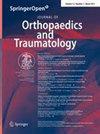Medium-term clinical results in the treatment of supracondylar humeral fractures in children: does the surgical approach impact outcomes?
IF 3.7
2区 医学
Q1 ORTHOPEDICS
引用次数: 0
Abstract
Recent literature has found a consensus in favor of conservative treatment for type II supracondylar humeral fractures (SCHF). This retrospective observational study compares the short- to medium-term functional outcomes of conservative versus surgical treatment in 31 patients with SCHF (Gartland II and III) to assess the potential superiority of one approach over the other. Thirty-one pediatric patients treated for SCHF—19 classified as Gartland II and 12 as Gartland III—were assessed in our department. Eight patients underwent closed reduction and cast immobilization, 22 were treated with closed reduction and percutaneous pinning, and one underwent open reduction and internal fixation with plates. Clinical and functional data were collected during follow-up, including elbow and forearm range of motion (ROM), grip strength, carrying angle, Flynn’s criteria, and Disabilities of the Arm, Shoulder, and Hand (DASH) score. The average follow-up was 3.3 years (± 1.4 years). All patients demonstrated good functional recovery. According to Flynn’s criteria, 85% and 81% of the patients achieved a satisfactory outcome in elbow flexion and carrying angle, respectively. No cases of nerve injuries were reported. Four patients developed cubitus varus in the Gartland II group, which was treated with closed reduction and casting with the initial alignment maintained (without a loss of reduction during the first week). However, compared to this group that was conservatively treated, functional and clinical outcomes were significantly better in the group with SCHF Gartland II treated with reduction and pinning (p < 0.05). Although some recent studies have demonstrated positive outcomes with conservative treatment for both Gartland IIA and IIB fractures, the short- to medium-term functional results in our study emphasize that superior outcomes were obtained with surgical treatment for Gartland II fractures when compared to those treated conservatively. Trial registration: This study was performed in line with the principles of the Declaration of Helsinki. Ethics approval was obtained from our institute’s ethics committee (registry no. 3511). Level of evidence: Therapeutic level III治疗儿童肱骨髁上骨折的中期临床结果:手术方法对疗效有影响吗?
最近的文献发现,II型肱骨髁上骨折(SCHF)的保守治疗已成为共识。这项回顾性观察研究比较了 31 名肱骨髁上骨折(Gartland II 型和 III 型)患者保守治疗与手术治疗的中短期功能效果,以评估两种治疗方法的潜在优劣。我们科室对 31 名接受治疗的 SCHF 儿童患者进行了评估,其中 19 名被归类为 Gartland II 型,12 名被归类为 Gartland III 型。8名患者接受了闭合复位和石膏固定术,22名患者接受了闭合复位和经皮穿刺固定术,1名患者接受了切开复位和钢板内固定术。随访期间收集了临床和功能数据,包括肘部和前臂的活动范围(ROM)、握力、搬运角度、Flynn标准以及手臂、肩部和手部残疾(DASH)评分。平均随访时间为 3.3 年(± 1.4 年)。所有患者的功能恢复情况良好。根据 Flynn 的标准,分别有 85% 和 81% 的患者在肘关节屈曲和搬运角度方面达到了满意的结果。无神经损伤病例报告。Gartland II 组中有四名患者出现肘关节畸形,该组患者接受了闭合复位和石膏固定治疗,并保持了最初的对位(第一周内没有出现复位)。然而,与接受保守治疗的这组患者相比,接受复位和固定治疗的 SCHF Gartland II 组患者的功能和临床疗效明显更好(P < 0.05)。尽管最近的一些研究表明,保守治疗对 Gartland IIA 和 IIB 型骨折都有积极的疗效,但我们研究中的中短期功能结果强调,与保守治疗相比,手术治疗 Gartland II 型骨折的疗效更佳。试验登记:本研究符合《赫尔辛基宣言》的原则。已获得本研究所伦理委员会的伦理批准(登记号:3511)。证据等级:治疗级别 III
本文章由计算机程序翻译,如有差异,请以英文原文为准。
求助全文
约1分钟内获得全文
求助全文
来源期刊

Journal of Orthopaedics and Traumatology
Medicine-Orthopedics and Sports Medicine
CiteScore
4.30
自引率
0.00%
发文量
56
审稿时长
13 weeks
期刊介绍:
The Journal of Orthopaedics and Traumatology, the official open access peer-reviewed journal of the Italian Society of Orthopaedics and Traumatology, publishes original papers reporting basic or clinical research in the field of orthopaedic and traumatologic surgery, as well as systematic reviews, brief communications, case reports and letters to the Editor. Narrative instructional reviews and commentaries to original articles may be commissioned by Editors from eminent colleagues. The Journal of Orthopaedics and Traumatology aims to be an international forum for the communication and exchange of ideas concerning the various aspects of orthopaedics and musculoskeletal trauma.
 求助内容:
求助内容: 应助结果提醒方式:
应助结果提醒方式:


